King Henry IV - 1399-1413
English Costume by Dion Clayton Calthrop
By Pauline Weston Thomas for Fashion-Era.com

English Costume by Dion Clayton Calthrop
HENRY THE FOURTH - 1399-1413.
This costume history information consists of Pages 152-160 of the chapter on early 15th century dress in the 14 year reign of Henry The Fourth 1399-1413 and taken from English Costume by Dion Clayton Calthrop.
The 36 page section consists of a text copy of the book ENGLISH COSTUME PAINTED & DESCRIBED BY DION CLAYTON CALTHROP. Visuals, drawings and painted fashion plates in the book have a charm of their own and are shown amid the text. The book covers both male and female dress history of over 700 years spanning the era 1066-1830.
This page is about dress in the reign of King Henry The Fourth 1399-1413. The images and details are a good resource for costuming Shakespeare's stage plays of the Plantagenet era.
For the Introduction to this book see this introduction written by Dion Clayton Calthrop. I have adjusted the images so they can be used for colouring worksheets where pupils add some costume/society facts.
My comments are in italics.
HENRY THE FOURTH
Reigned fourteen years: 1399-1413.
Born 1366. Married, 1380, Mary de Bohun; 1403, Joan of Navarre.
A MAN AND WOMAN OF THE TIME OF HENRY IV - 1399-1413
Very little change in dress; the man in the loose gown called the houppelande. The woman also in a houppelande.
THE MEN AND WOMEN
The reign opens sombrely enough - Richard in prison, and twenty-five suits of cloth of gold left, among other of his butterfly raiment, in Haverford Castle.
We are still in the age of the houppelande, the time of cut edges, jagging, big sleeves and trailing gowns. Our fine gentlemen take the air in the long loose gown, or the short edition of the same with the skirts cut from it. They have invented, or the tailor has invented, or necessity has contrived, a new sleeve. It is a bag sleeve, very full and fine, enormous at the elbow, tight at the wrist, where it may fall over the hand in a wide cuff with dagged edges, or it may end in a plain band.
Six Gentleman & Their Houppelandes
Let us take six gentlemen met together to learn the old thirteenth-century part-song, the round entitled 'Sumer is icumen in.'
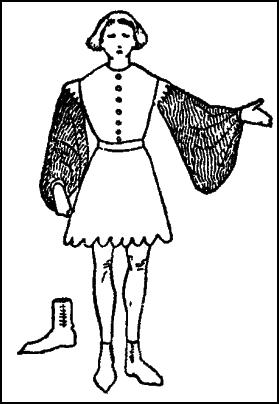
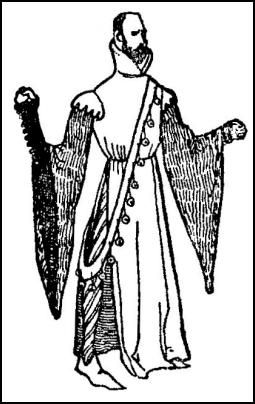 The first, maybe, is in the high-collared houppelande with the long skirts; his sleeves are of a different colour to his gown, and are fastened to it under cut epaulettes at his shoulders; he wears a baldrick, hung with bells, over his shoulder; his houppelande is split on one side to show his parti-coloured hose beyond his knee; his shoes are long and very pointed; his hair is cut short, and he wears a twisted roll of stuff round his head.
The first, maybe, is in the high-collared houppelande with the long skirts; his sleeves are of a different colour to his gown, and are fastened to it under cut epaulettes at his shoulders; he wears a baldrick, hung with bells, over his shoulder; his houppelande is split on one side to show his parti-coloured hose beyond his knee; his shoes are long and very pointed; his hair is cut short, and he wears a twisted roll of stuff round his head.
The second is in the latest mode; he wears the voluminous sleeves which end in a plain band at his wrist, and these sleeves are of a different colour to his houppelande, the skirts of which are cut short at the knee, and then are cut into neat dags. This garment is not so full as that of the first gentleman, which is gathered in at the waist by a long-tongued belt, but is buttoned down the front to the waist and is full in the skirt; also it has no collar. This man wears his hair long and curled at the nape of his neck.
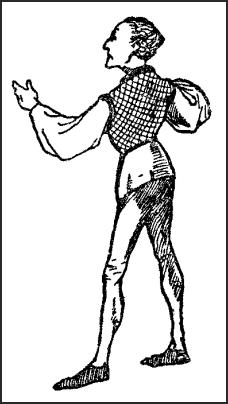
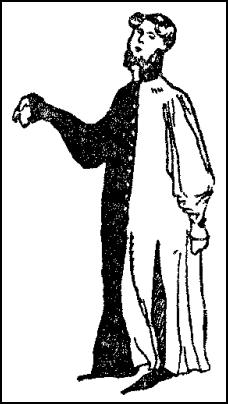 A third of these gentlemen, a big burly man, is in a very short tunic with wide sleeves; his tights are of two colours, his left leg red, his right blue. Over his tunic he wears a quilted waistcoat, the collar and armholes of which are trimmed with fur.
A third of these gentlemen, a big burly man, is in a very short tunic with wide sleeves; his tights are of two colours, his left leg red, his right blue. Over his tunic he wears a quilted waistcoat, the collar and armholes of which are trimmed with fur.
A fourth wears a loose houppelande, one half of which is blue and the other half black; it is buttoned from throat to foot; the sleeves are wide. His hair is long, and his beard is brushed into two points.
The fifth gentleman wears a houppelande of middle length, with a very high collar buttoned up the neck, the two top buttons being undone; the top of the collar rolls over. He has the epaulette, but instead of showing the very full bag sleeves he shows a little loose sleeve to the elbow, and a tight sleeve from the elbow to the hand, where it forms a cuff. He wears a very new-fashioned cap like a stiff sugar-bag, with the top lopping over.
The sixth and last of this group is wearing an unbound houppelande - that is, he wears no belt. He wears a plain hood which is over his head, and a soft, loose, peaked hat.
'Sumer is icumen in,' the six sing out, and the shepherd, who can hear them from outside, is considering whether he can play the air upon his pipe. He is dressed in a loose tunic, a hood, and a wide-brimmed straw hat; his pipe is stuck in his belt.
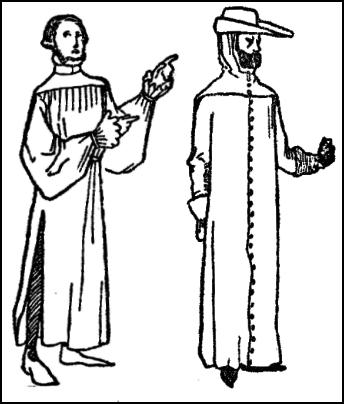

More Male Fashions -
Houppelandes & Headwear
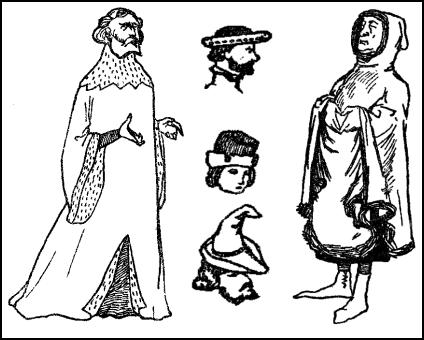
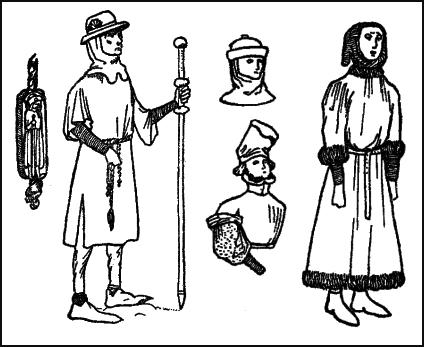
The Women - The Wives
Let us suppose that the wives of the six gentlemen are seated listening to the manly voices of their lords.
The first wears a dress of blue, which is laced from the opening to the waist, where the laces are tied in a neat bow and hang down. Her dress is cut fairly low; it has tight sleeves which come over her hands to the knuckles in tight cuffs. There is a wide border, about a foot and a half, of ermine on the skirt of her dress. She wears a mantle over her shoulders. Her hair is enclosed in a stiff square caul of gold wire over cloth of gold.
The second lady is wearing a houppelande with wide, hanging sleeves all cut at the edge; the cut of this gown is loose, except that it fits across her shoulders; she also wears a caul, from the back of which emerges a linen wimple.
The third lady is in surcoat and cotehardie; the surcoat has a pleated skirt, and the borders of it are edged thickly with fur; it is cut low enough at the sides to show a belt over the hips. The cotehardie, of a different colour to the surcoat, has tight sleeves with buttons from elbow to little finger. This lady has her hair cut short at the nape of her neck, and bound about the brows with a golden circlet.
A fourth wears a very loose houppelande, encircled about the waist with a broad belt, the tongue of which hangs down and has an ornamented end. This houppelande falls in great folds from the neck to the feet, and is gathered into the neck; it has loose, but not wide, sleeves, falling just below the elbow. The gown is worn over a cotehardie, the sleeves of which show through the other sleeves, and the skirt of which shows when the gown skirt is gathered up.
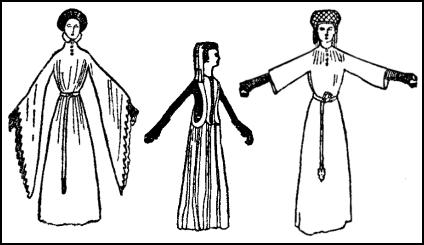
The fifth lady also wears a cotehardie with a skirt to it; she wears over it a circular mantle, buttoned by three buttons on the right shoulder, and split from there to the edge on both sides, showing the dress; the front semicircle of the cloak is held to the waist by a belt so that the back hangs loose. Her hair is in a caul.
 The sixth is in a very plain dress, tight-fitting, buttoned in front, with full skirts. She wears a white linen hood which shows the shape of the caul in which her hair is imprisoned.
The sixth is in a very plain dress, tight-fitting, buttoned in front, with full skirts. She wears a white linen hood which shows the shape of the caul in which her hair is imprisoned.
So is this queer old round sung, 'Sumer is icumen in.'
The Witch
Afterwards, perhaps one of these ladies, wishing to get some spite against one of the gentlemen, will ride away in a heavy riding-cloak, the hood over her head and a peaked hat on that, and she will call upon a witch. The witch will answer the rapping at her humble door, and will come out, dressed in a country dress - just an ill-fitting gown and hood, with some attempt at classical ornament on the gown, or a cloak sewn with the sacred initials thrown over her back.
These two will bargain awhile for the price of a leaden image to be made in the likeness of the ill-fated gentleman, or, rather, a rough figure, on which his name will be scratched; then the puppet will be cast into the fire and melted while certain evil charms are spoken, and the malicious accident required to befall him will be spoken aloud for the Devil's private ear.
Possibly some woman sought a witch near Evesham in the year 1410, and bought certain intentions against a tailor of that place, Badby by name; for this much is certain: that the tailor was burnt for Lollardy ten years after the first victim for Lollard heresy, William Sawtre.
§
HENRY THE FOURTH
Reigned fourteen years: 1399-1413.
Born 1366. Married, 1380, Mary de Bohun; 1403, Joan of Navarre.
This costume history information consists of Pages 152-160 of the chapter on early 15th century dress in the 14 year reign of Henry The Fourth 1399-1413 and taken from English Costume by Dion Clayton Calthrop.
The 36 page section consists of a text copy of the book ENGLISH COSTUME PAINTED & DESCRIBED BY DION CLAYTON CALTHROP. Visuals, drawings and painted fashion plates in the book have a charm of their own and are shown amid the text. The book covers both male and female dress history of over 700 years spanning the era 1066-1830.
This page is about dress in the reign of King Henry The Fourth 1399-1413, The images and details are a good resource for costuming Shakespearean stage plays of the Plantagenet era.
For the Introduction to this book see this introduction written by Dion Clayton Calthrop. I have adjusted the images so they are mostly 400 pixels high and can be used for colouring worksheets where pupils add some costume/society facts.
My comments are in italics.
You have been reading English Costume History at www.fashion-era.com © from the chapter Henry The Fourth 1399-1413, from Dion Clayton Calthrop's book English Costume.